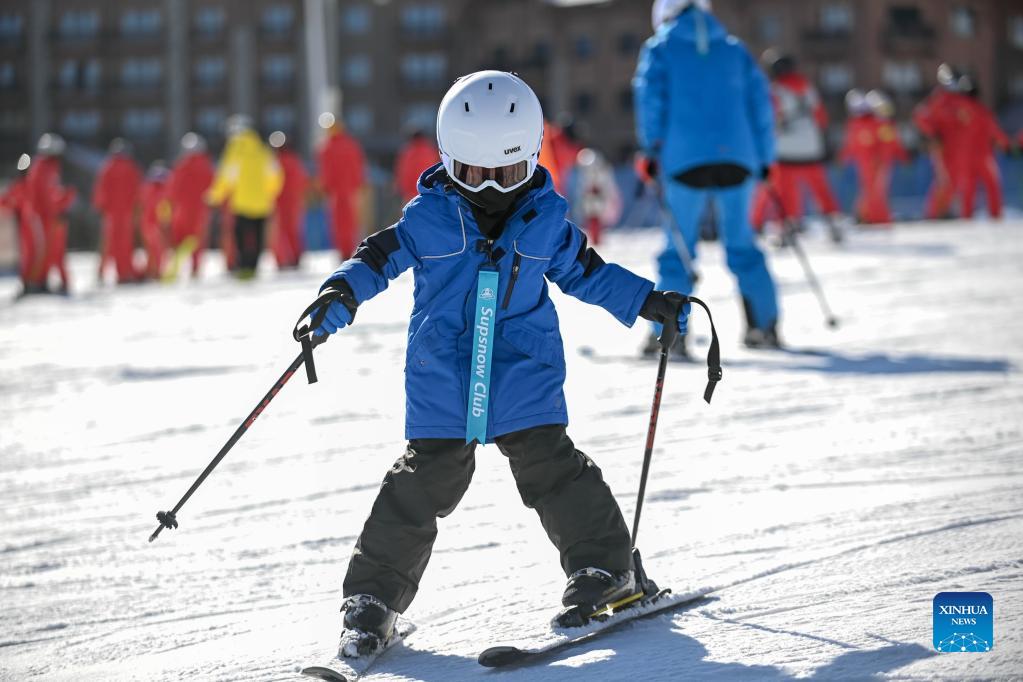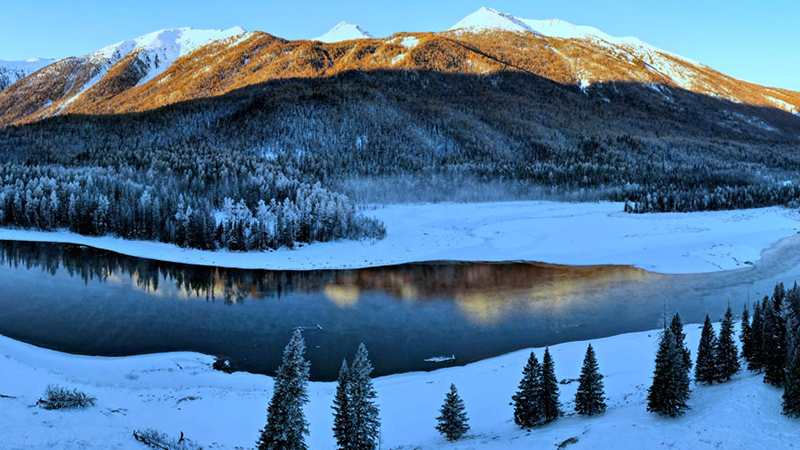China’s winter sports industry booming as sporting enthusiasts expand consumption of snow and ice activities
How long does it take a person to fall in love with winter sports? The answer for Yang He was the mere duration of a single trip. After the man experienced skiing at a ski resort in Chongli of Zhangjiakou City, north China’s Hebei Province in 2015, he instantly fell in love with the sporting activity and now visits the ski resort every winter.

A child skies at White Mountain Resort in Fusong, northeast China's Jilin Province, Nov. 19, 2021. As the 2022 Beijing Winter Olympics approaches, ski resorts in Jilin are seeing an increasing visits by children, many of whom take courses with the support of their ski-loving parents. (Xinhua/Yan Linyun)
After China won the bid to host the 2022 Winter Olympic Games in 2015, there has been a rising number of people in the country who have developed an interest in snow and ice sports. A report on Chinese people’s consumption spending habits related to snow and ice sports published in 2020 indicated that during the 2018-2019 winter season, about 224 million Chinese made at least one trip related to winter snow and ice activities, with per capita spending standing at 5,000 yuan per trip.
Yang rented out a locker at the ski resort to store his equipment. “At first, I rented skiing equipment from the resort, and then I bought my first ski suit for 200 yuan. During the past six years, I invested more and more into the hobby, having bought myself a complete set of ski equipment, and this November, I bought a snowboard for nearly 10,000 yuan,” Yang revealed.
Data from online marketplace JD.com showed that during this year’s “Double 11” shopping festival, orders for ski equipment increased by 23 times year-on-year on the platform, while the transaction volume for ice sports equipment increased 15 times year-on-year.
Six-year-old Shen Luchen is a first grader at a primary school in Beijing who has been learning figure skating for two years. According to her mother, the training courses constitute a major part of the total cost associated with learning skiing, with a one-hour training lesson costing anywhere between 200 to 400 yuan. However, she thought the money was well spent because the girl has learnt how to stay focused, improving her body coordination and becoming more confident on the slopes.
Snow and ice tourism is also gaining increasing momentum in China. According to a report on the development of snow and ice tourism in the country, 55 percent of respondents said that they are willing to engage in a long-distance trip related to winter ice and snow activities, while 82 percent meanwhile said that they are willing to take part in a short-distance trip featuring ice and snow activities.
The owners of ice and sports stadiums are some of the primary beneficiaries of the latest snow and ice sports craze. The Chen Lu International Skating Center located in Beijing’s Chaoyang district is among them. According to Yang Yiwei, general manager of the center, when the center went into operation in 2017, there was just one ice hockey team, and now there are eight, with 220 students coming to the center to receive training regularly.
China has continued to improve upon and expand infrastructure for snow and ice sports. According to data published by the General Administration of Sports of China, at the beginning of 2021, the country had 654 standard ice rinks and 803 outdoor ski resorts, up 317 percent and 41 percent, respectively, from 2015.
Before opening its door to ski enthusiasts at the end of November, Beijing Nanshan Ski Resort located in Beijing’s Miyun district had just finished upgrading its ski facilities, as well as improving its catering services and implementing robust epidemic prevention and control measures, all in a bid to get ready for the peak season.
“While the country is preparing for the Games, we’ve also been constantly improving our infrastructure. During the last winter season, we saw more than 400,000 visitors,” said Hu Wei, general manager of the ski resort. Starting in 2018, the ski resort rolled out nighttime skiing to woo ski lovers to take full advantage of their time on the slopes, having received more than 50,000 visitors that year. In 2020, that figure had risen to reach 90,000 visitors to the resort’s nighttime skiing slopes, Hu disclosed.
Photos
Related Stories
- Creative pics: hand-painted "athletes" depicted in winter games art
- Highlights of Experience Beijing FIL Luge World Cup
- Beijing 2022 encourages winter sports industry in Baiyin
- Pic story: 12-year-old boy chases figure skating dream
- Cooperation on winter sports boosts bilateral ties between China and Finland: Finnish ambassador
- Winter sports courses heat up N China's school campus
- Expo showcases China’s winter sports strength
Copyright © 2021 People's Daily Online. All Rights Reserved.










